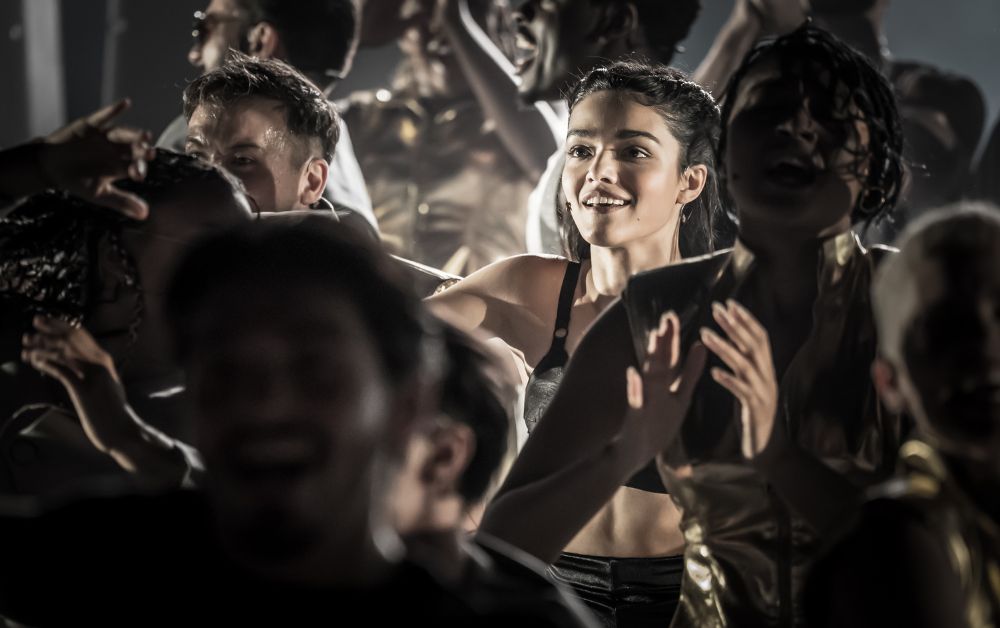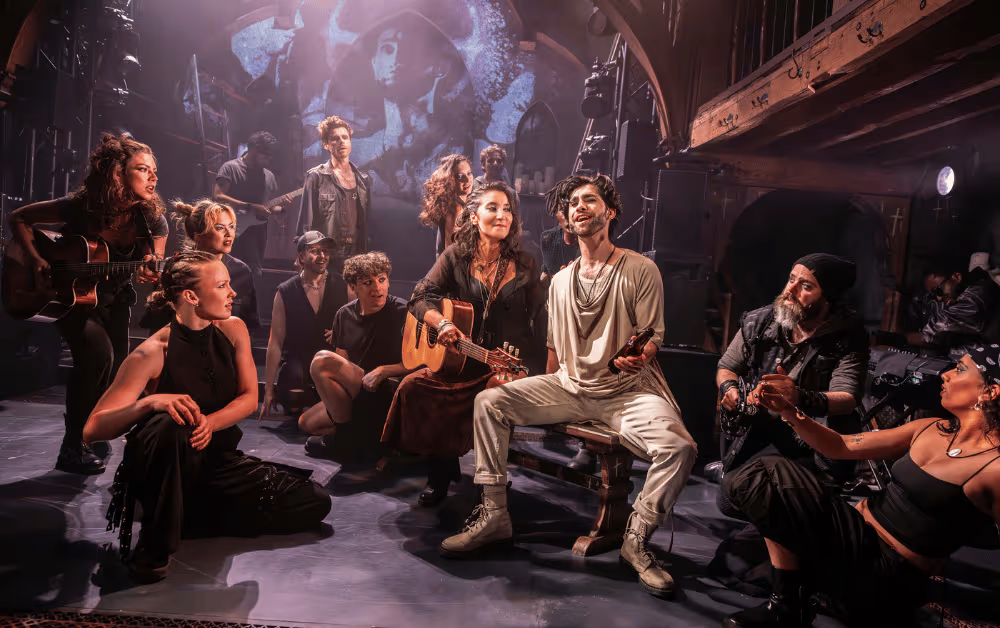Who’s who in the world of Evita?
You probably know the name Eva Perón, but to paraphrase Evita’s narrator Che, just who was “Santa Evita”?
From beloved First Lady to folk legend, the story of Evita is as much about the people who made Eva Perón an icon as it is about her personal journey through rural poverty and B-movie success to political superstardom.
So, allow us to introduce the cast of characters that make Evita’s story sing, presented (roughly) in order of appearance.
The Crowd
There would be no Eva Perón to deliver ‘Don’t Cry For Me Argentina’ if there was no crowd to hear her every word, so it’s fitting that it is the voices of the people we hear first.
As Evita begins, we join a crowd of mourners singing a requiem for their much-admired First Lady of Argentina. These are the people who love Eva Perón and have carried her throughout her political life and who continue to carry her story.

Che
Observant and critical, obsessive and cynical, the character of Che functions as Evita’s narrator. His is the first principal voice to be heard during the show as he stalks around the stage critiquing the woman everyone seemingly adores: the “Santa Evita” he refers to as a “Goddess” with dripping sarcasm in ‘Oh, What a Circus.’
Che is an everyman, loosely representative of the kind of working class voter the real Eva Peron was popular with, although he is not based on a specific historical figure as others are.
This means Che is pretty much ever-present. He’s often onstage, he’s always watching Eva, and he’s usually doing it through critical eyes. Che is not taken in by Eva as so many of his compatriots seem to be, and his observations about her – the ruthlessness with which she pursues her ambition, for example – provide a counterpoint to the glitz and glamour of Eva’s life.
It's true that "Che" was invented for Evita but director Hal Prince encouraged his actors to read up on Che Guevara to influence his interpretation within the first production - wit future interpretations choosing to keep Che as an anonymous figure rather than linking him to Guevara
As a character, Che’s commentary provides context to audiences who might not be familiar with the historical story behind Evita, and he also functions as a voice of the people Eva purports to represent.

Eva Perón
Spoiler alert: whilst it is her image on the poster, Evita begins with Eva Perón’s death!
The historical Eva Perón, whose life and legacy inspired Evita, died young, at the age of 33 from cervical cancer. It was 1952, and she’d only been married to her husband, President Juan Perón, for 7 years. But in that time, she’d already established herself as a central figure within his Peronist political party, and was immensely popular with the public, especially working-class women.
Born María Eva Duarte on 7 May 1919 in Argentina's Pampas region, the woman who would become so beloved by her people and named ‘Spiritual Leader of the Nation of Argentina’ grew up in poverty, dreaming from an early age of becoming an actress.
Evita includes many real biographical details from Eva’s life. In the show she first appears in a city called Junin – the place where the real Eva grew up – and Che tells us she is just 15. Here, she meets a “tango singer” and runs away to Buenos Aires with him, all of which mirrors her history.
Che’s narration underlines what a complicated character Eva is, but whether she deserves all that cynicism is up for debate. An actress through and through, she is undoubtedly able to turn situations to her advantage and has an unswerving ambition that she pursues fearlessly – but she’s also beloved by her people, to whom she appears reciprocate that love. Like all stars, she has many sides.

Agustín Magaldi
The “tango singer” Eva runs off to Buenos Aires with is Agustín Magaldi, another character based on a real historical figure. The real Magaldi’s relationship with the woman who became Eva Perón is hard to pin down, though, so whether he truly did take a 15-year-old Eva to Buenos Aires is unconfirmed.
In the show, Magaldi is charmed by young Eva and so attempts to charm her, before being manipulated into taking her with him to the big city. Che’s dismissive description of Magaldi is of someone “who has the distinction of being the first man to be of use to Eva Duarte,” and he’s certainly dropped by Eva pretty quickly once she’s established herself in the city.

Juan Perón
Eva meets the man who becomes her husband, Juan Perón, at a charity concert “in aid of the victims of an earthquake that devastated the town of San Juan,” as Che tells us. Perón is, of course, another real historical figure – he was a Colonel when Eva met him, before becoming the 29th president of Argentina – and he and Eva really did meet at a charity event for earthquake victims. They were married within a year, and Perón seems to have recognised quickly that Eva could be a huge asset to him politically because of her immense popularity with his party supporters.
However, she’s certainly not popular with Argentina’s aristocrats and its military faction. History records that these groups challenged Eva’s candidacy when she tried to run as Vice President of Argentina before her death. In Evita, they are dismissive, disdainful and derogatory, insulting Eva repeatedly in ‘Perón’s Latest Flame’.
As a former member of the military himself, this might have been challenging for Perón, but it seems to have had no influence on his relationship with Eva. True love? Perhaps, but it’s also obvious that Perón is just as ambitious as his ‘Latest Flame’. He’s not about to let Eva’s critics prevent him from harnessing her popularity and making her his wife. Not surprisingly, the Peróns are well matched.

The Mistress
One person Eva is no good for is Perón’s mistress. In fact, this woman is so seemingly insignificant to the Perón's she is not even named, which means we can’t know if she was based on a genuine historical figure. It isn’t even Perón who dismisses her, it’s Eva who sends her packing.
And yet – whilst the Mistress may be a sad and fragile character, she performs one of Evita’s best-known and much-loved songs. ‘Another Suitcase in Another Hall’ is beautiful in its vulnerability, and in striking contrast to the self-assured confidence of the powerhouse songs performed by Eva Perón. Like Che, the Mistress is a character who provides the audience with a different point of view.

This was a Box Five Club Exclusive
Members of The Box Five Club had access to this story before anybody else.
By signing up, you’ll be among the first to receive exclusive content, special announcements, and behind-the-scenes updates, delivered straight to your inbox, as well as gaining access to the exclusive Box Five store. Join now and stay connected to all things Andrew Lloyd Webber!


Andrew Lloyd Webber's Starlight Express At Troubadour Wembley Park Theatre Confirms Final Extension

Andrew Lloyd Webber's Starlight Express At Troubadour Wembley Park Theatre Confirms Final Extension
Andrew Lloyd Webber's Starlight Express At Troubadour Wembley Park Theatre Confirms Final Extension
Andrew Lloyd Webber's Starlight Express At Troubadour Wembley Park Theatre Confirms Final Extension


Opera Australia announces its exceptional trio for Phantom of the Opera at Handa Opera on Sydney Harbour

Opera Australia announces its exceptional trio for Phantom of the Opera at Handa Opera on Sydney Harbour
Opera Australia announces its exceptional trio for Phantom of the Opera at Handa Opera on Sydney Harbour
Opera Australia announces its exceptional trio for Phantom of the Opera at Handa Opera on Sydney Harbour


Andrew Lloyd Webber’s Evita Receives Nine Nominations For The 26th WhatsOnStage Awards

Andrew Lloyd Webber’s Evita Receives Nine Nominations For The 26th WhatsOnStage Awards
Andrew Lloyd Webber’s Evita Receives Nine Nominations For The 26th WhatsOnStage Awards
Andrew Lloyd Webber’s Evita Receives Nine Nominations For The 26th WhatsOnStage Awards


Jesus Christ Superstar at the Watermill Theatre Nominated for Three WhatsOnStage Awards

Jesus Christ Superstar at the Watermill Theatre Nominated for Three WhatsOnStage Awards
Jesus Christ Superstar at the Watermill Theatre Nominated for Three WhatsOnStage Awards
Jesus Christ Superstar at the Watermill Theatre Nominated for Three WhatsOnStage Awards
%20(1).png)

Andrew Lloyd Webber Celebrates BRIT School's Phantom Production











.avif)




